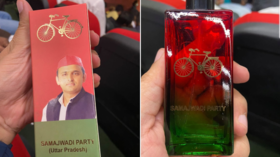Toxic smog engulfs Delhi
The Indian Central Pollution Control Board (CPCB) has warned people against going outdoors, and called on state leaders to be in “complete readiness” for emergency measures, amid worsening air pollution in the nation’s capital.
In a circular on Friday, the CPCB called on the government and private businesses alike to reduce private transport usage by 30%, and advised citizens not to expose themselves to Delhi’s toxic smog.
The warning came amid worsening air pollution in the National Capital Region. “Meteorological conditions will be highly unfavorable for dispersion of pollutants till November 18, 2021, due to low wind speed … and calm conditions during the night,” the board said.
“Concerned state and implementing agencies must be in complete readiness for implementation of measures under ‘Emergency’ category as per GRAP [Graded Response Action Plan],” it said.
The pollution board’s Graded Response Action Plan requires local authorities to impose emergency measures if air quality remains in the ‘severe’ category for 48 hours. These measures include shutting schools, stopping all construction work, and restricting private car usage. The 24-hour-average air quality index (AQI) readings for the National Capital Region reached 471 on a scale of 500 by 4pm local time on Friday. A day earlier, they had been 411, according to Indian media.
The dense smog covering the city is known to contain dangerous levels of poisonous airborne particulate matter that can cause cardiovascular and respiratory disease. Following Diwali celebrations at the weekend, the levels of one particular particulate, PM2.5, averaged 706 micrograms. For context, the World Health Organization considers annual PM2.5 levels above five micrograms as unsafe.
In an effort to bring the smog under control, the authorities have ordered the operation of brick kilns to be halted. There’s also been a crackdown on garbage-burning and any activities that stir up dust.
Earlier this week, a toxic foam gathered on the Yamuna river, which flows through the National Capital Region. Understood to have been caused by high levels of ammonia and phosphates, the white froth can cause both skin irritation and respiratory problems.
If you like this story, share it with a friend!
















